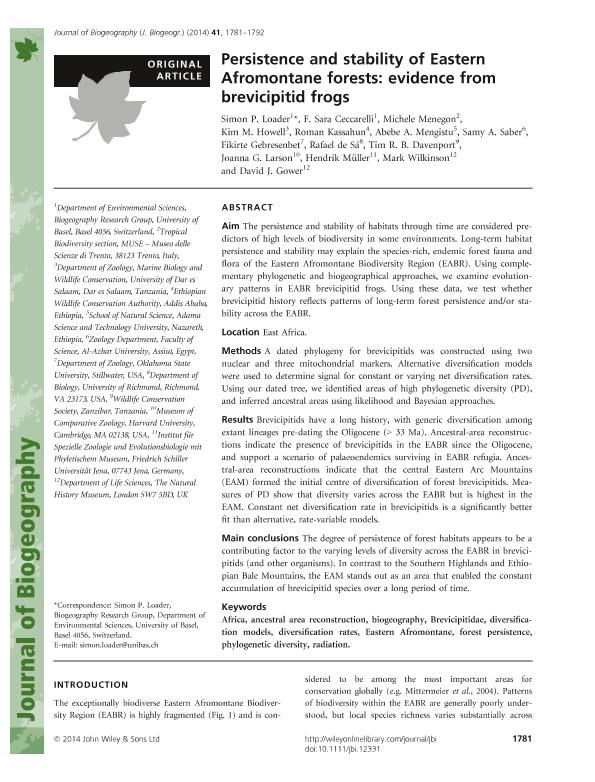Mostrar el registro sencillo del ítem
dc.contributor.author
Loader, Simon P.
dc.contributor.author
Ceccarelli, Fadia Sara

dc.contributor.author
Menegon, Michele
dc.contributor.author
Howell, Kim M.
dc.contributor.author
Kassahun, Roman
dc.contributor.author
Mengistu, Abebe A.
dc.contributor.author
Saber, Samy A.
dc.contributor.author
Gebresenbet, Fikirte
dc.contributor.author
de Sa, Rafael
dc.contributor.author
Davenport, Tim R. B.
dc.contributor.author
Larson, Joanna G.
dc.contributor.author
Müller, Hendrik
dc.contributor.author
Wilkinson, Mark
dc.contributor.author
Gower, David J.
dc.date.available
2017-12-05T17:50:36Z
dc.date.issued
2014-09
dc.identifier.citation
Loader, Simon P.; Ceccarelli, Fadia Sara; Menegon, Michele; Howell, Kim M.; Kassahun, Roman; et al.; Persistence and stability of Eastern Afromontane forests: evidence from brevicipitid frogs; Wiley; Journal of Biogeography; 41; 9; 9-2014; 1781-1792
dc.identifier.issn
0305-0270
dc.identifier.uri
http://hdl.handle.net/11336/29751
dc.description.abstract
Aim: The persistence and stability of habitats through time are considered predictors of high levels of biodiversity in some environments. Long-term habitat persistence and stability may explain the species-rich, endemic forest fauna and flora of the Eastern Afromontane Biodiversity Region (EABR). Using complementary phylogenetic and biogeographical approaches, we examine evolutionary patterns in EABR brevicipitid frogs. Using these data, we test whether brevicipitid history reflects patterns of long-term forest persistence and/or stability across the EABR. Location: East Africa. Methods: A dated phylogeny for brevicipitids was constructed using two nuclear and three mitochondrial markers. Alternative diversification models were used to determine signal for constant or varying net diversification rates. Using our dated tree, we identified areas of high phylogenetic diversity (PD), and inferred ancestral areas using likelihood and Bayesian approaches. Results: Brevicipitids have a long history, with generic diversification among extant lineages pre-dating the Oligocene (> 33 Ma). Ancestral-area reconstructions indicate the presence of brevicipitids in the EABR since the Oligocene, and support a scenario of palaeoendemics surviving in EABR refugia. Ancestral-area reconstructions indicate that the central Eastern Arc Mountains (EAM) formed the initial centre of diversification of forest brevicipitids. Measures of PD show that diversity varies across the EABR but is highest in the EAM. Constant net diversification rate in brevicipitids is a significantly better fit than alternative, rate-variable models. Main conclusions: The degree of persistence of forest habitats appears to be a contributing factor to the varying levels of diversity across the EABR in brevicipitids (and other organisms). In contrast to the Southern Highlands and Ethiopian Bale Mountains, the EAM stands out as an area that enabled the constant accumulation of brevicipitid species over a long period of time.
dc.format
application/pdf
dc.language.iso
eng
dc.publisher
Wiley

dc.rights
info:eu-repo/semantics/openAccess
dc.rights.uri
https://creativecommons.org/licenses/by-nc-sa/2.5/ar/
dc.subject
Africa
dc.subject
Biogeography
dc.subject
Brevicipitidae
dc.subject.classification
Otras Ciencias Biológicas

dc.subject.classification
Ciencias Biológicas

dc.subject.classification
CIENCIAS NATURALES Y EXACTAS

dc.title
Persistence and stability of Eastern Afromontane forests: evidence from brevicipitid frogs
dc.type
info:eu-repo/semantics/article
dc.type
info:ar-repo/semantics/artículo
dc.type
info:eu-repo/semantics/publishedVersion
dc.date.updated
2017-12-04T20:04:33Z
dc.journal.volume
41
dc.journal.number
9
dc.journal.pagination
1781-1792
dc.journal.pais
Estados Unidos

dc.journal.ciudad
Hoboken
dc.description.fil
Fil: Loader, Simon P.. Universidad de Basilea; Suiza
dc.description.fil
Fil: Ceccarelli, Fadia Sara. Universidad de Basilea; Suiza. Consejo Nacional de Investigaciones Científicas y Técnicas; Argentina
dc.description.fil
Fil: Menegon, Michele. Museo delle Scienze di Trento; Italia
dc.description.fil
Fil: Howell, Kim M.. University of Dar es Salaam; Tanzania
dc.description.fil
Fil: Kassahun, Roman. Ethiopian Wildlife Conservation Authority; Etiopía
dc.description.fil
Fil: Mengistu, Abebe A.. Adama Science and Technology University; Etiopía
dc.description.fil
Fil: Saber, Samy A.. Al-Azhar University; Egipto
dc.description.fil
Fil: Gebresenbet, Fikirte. Oklahoma State University; Estados Unidos
dc.description.fil
Fil: de Sa, Rafael. University of Richmond; Estados Unidos
dc.description.fil
Fil: Davenport, Tim R. B.. Wildlife Conservation Society; Tanzania
dc.description.fil
Fil: Larson, Joanna G.. Harvard University; Estados Unidos
dc.description.fil
Fil: Müller, Hendrik. Universitat Jena; Alemania
dc.description.fil
Fil: Wilkinson, Mark. Natural History Museum; Reino Unido
dc.description.fil
Fil: Gower, David J.. Natural History Museum; Reino Unido
dc.journal.title
Journal of Biogeography

dc.relation.alternativeid
info:eu-repo/semantics/altIdentifier/doi/http://dx.doi.org/10.1111/jbi.12331
dc.relation.alternativeid
info:eu-repo/semantics/altIdentifier/url/http://onlinelibrary.wiley.com/doi/10.1111/jbi.12331/abstract
Archivos asociados
